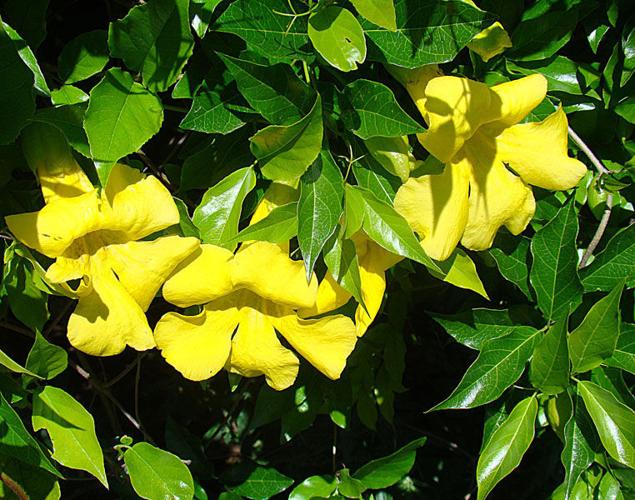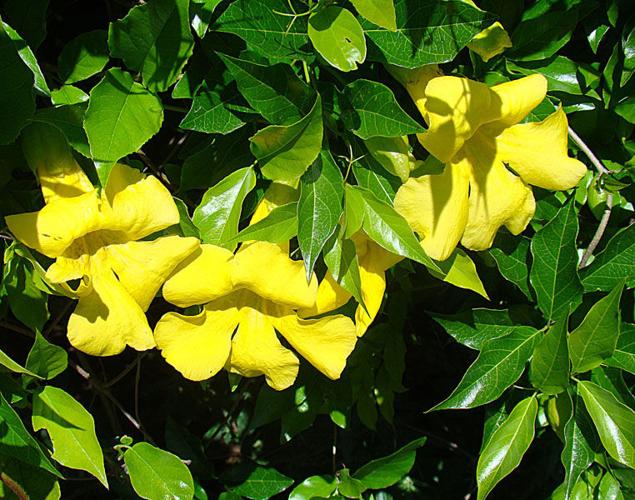Q: We have chickens running free in a backyard of citrus trees, and to protect the flock I’ve avoided using granular citrus fertilizer to feed those trees. I’ve used water-soluble general plant food followed with a top dress of compost or mulch, but want to meet the particular nutritional needs of the citrus. How would you suggest fertilizing the citrus?
A: The way you are fertilizing is fine. The important information to know is how much nitrogen, phosphorus, and potassium (potash) is in your water-soluble plant food. The percent of these three nutrients contained in a particular product are usually listed in that order, separated by dashes, on the front of the fertilizer container. Once you know the percent nitrogen, you can cross-reference that with the size the tree in our handy chart to determine how much fertilizer to put down. The difficult thing to know about compost and mulch is the amount of nitrogen available to the plant. The good companies put an analysis of the compost on the bag but still you have to wait for the compost to be watered into the root zone and that can take varying amounts of time dependent on your soil type and how much water is used. The nice thing about compost and mulch is that independent of the nutrients they provide, there is protection of the root zone that can moderate temperature extremes and increase the water holding capacity of the root zone. By the way, depending on how many chickens you have, you may be getting significant additional fertilizer from them.
Q: I live in Tucson (caliche paradise). I have a ruby red grapefruit tree in my patio. It is 20 years old, 17 feet tall. Over the years I have trimmed it into a nice shade tree that gives us 150 square feet of shade. It has four separate trunks off the main trunk. The main trunk is 38 inches in circumference. I just harvested it and counted over 500 large grapefruit. I have not fed it in the last 10 years. I deep water every 10 days in the summer and once a month in winter. What is the normal life span? What am I doing wrong?
A: Grapefruit trees do not need a lot of fertilizer. A mature tree of the size you described probably has roots extending past the patio and receiving fertilizer from your turfgrass, garden, etc. Or perhaps the site is on a former agriculture field and there is still some residual fertilizer left in the soil. Or perhaps there is fertilizer in the irrigation water. Sooner or later, the tree will show nutrient deficiencies. Maybe it already is, but your yield is not yet affected. Grapefruit trees can live to be 50 years under ideal conditions but insects, diseases, and user errors often take their toll and shorten life spans. Your irrigation schedule seems to be on track so other than finding a way to add some fertilizer to the outer root zone, I think you are doing a fine job taking care of your tree.
Q: We are planting cat claw vines along a fence line for privacy. We chose cat claw for its low water use, fast growing and lower temperature tolerance. We live in Catalina at 3,140 feet. Our soil is gravelly sandy silt for 18 inches with a silty clay layer below. We have built 4-foot wide by 8-foot tall trellises to cover the 50-foot stretch along a chain link fence on the south side of our house. The trellises are rebar and four-by-four-inch welded mesh panels. I just read that cat claw may not be suitable for planting on wire. Why? I had not read that before. If it’s about strength shouldn’t what we have built support them? How far apart should we plant the vines, the nursery told us five feet. Would four feet be too close? Would one foot from the fence be appropriate?
A: The reason wire fences are not recommended is because the foliage of cat claw vine (Macfadyena unguis-cati) tends to concentrate near the top of the plant making it top heavy. The average wire fence would likely not support such a heavy plant. Rebar and welded mesh panels are probably tougher than the wire fence you read about. You might need to add horizontal stretches of wire to prevent the vine from pulling away once it fully covers the trellis. This is a fairly aggressive vine and should ultimately fill in the gaps when planted five feet apart. Growth should start slow and speed up once it becomes established. One foot from the fence seems right.
Q: I have attached a photo of my coral aloe (Aloe striata). After much searching, I believe the hideous, growth seen in the photo is aloe cancer/gall/mite? I have dug up, bagged and put the plant in the trash. Apparently, I can never have another aloe again except Blue Elf? Is this true, and is this wretched little mite a menace to my neighbor’s aloes? Is there anything else I should do? It makes me almost miss the killing freezes in Colorado!
A: I believe you are correct about the diagnosis. That appears to be damage caused by the eriophyid mite (Aceria aloinis). Because these mites are microscopic, it is difficult to know they are there until the damage is seen. There is some anecdotal evidence that the “Blue Elf” variety of aloe is unaffected but there is no science to back this up that I have seen. On the other hand, other known host plants include the aloe species arborescens, dichotoma, nobilis, and spinossima as well as Haworthia species. In general, I don’t see these mites as a widespread problem so I wouldn’t put all my aloe investments in one species. They are sporadic pests on aloes and based on the number of questions I get, many people don’t have a problem with them. These mites can spread by crawling and by wind. Because they can’t fly it isn’t a quickly spreading problem and your neighbor’s plants could very well be safe from infestation. What you did by bagging the infested plant and disposing of it is the best thing to do and probably enough to stop it from spreading.







